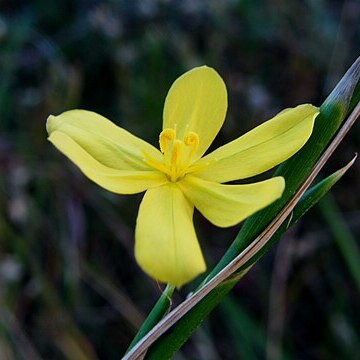Perennial herb, geophyte, 0.2-0.9 m high; corm symmetric, tunics brown, fibrous; stem usually with 1-3 branches near base. Leaves 1-3(4), ascending, linear, canaliculate, margins sometimes inrolled or rarely undulate. Spathe herbaceous, dry above, attenuate. Inflorescence a spike; flowers golden-yellow, stellate, nectar guides deeper yellow, surrounded by dark greenish spots; tepals free, 19-30 x 7-13 mm, limbs horizontal, outer ovate, inner ± cuneate. Stamens: 4-6 mm long; filaments united for 1.0-1.5 mm; anthers 5-7 mm long. Ovary exserted at flowering time; style ± 2 mm long, style branches spreading, 6-7 mm long. Flowering time Sept.-Nov. Capsule narrowly cylindric.
Corm 1.5–2 cm diam. Leaves 1–3, 70–80 cm long, 3–5 mm wide, lax. Scape 20-60 cm tall with 1–6 flexuose branches; bracts imbricate, acuminate, 4–7 cm long. Rhipidia 4-or 5-flowered, sessile along branches. Spathes 2.5–4 cm long. Flowers on pedicels c. 3 cm long, partly exserted. Perianth segments shortly clawed, spreading, deep yellow. Sepals oblong, 1.8–2.4 cm long, 7–9 mm wide. Petals obovate, slightly shorter. Filaments 5–6 mm long, connate at base only; anthers 5–7 mm long. Ovary c. 1 cm long; style branches 6–7 mm long, spreading horizontally between stamens. Capsule cylindrical, 1.5–2 cm long, exserted.
Cormous geophyte, 200-900 mm tall, usually 2-or 3-branched, with lateral flower clusters sessile. Leaves 1-3, linear, channelled, trailing above. Flowers enclosed by green to partly dry spathes, yellow, tepals spreading, style with 6 filiform arms extending between the stamens.
Cormous geophyte, 20-90 cm. Leaves 1-3, linear, channelled and trailing. Flowers deep yellow. Capsules oblong to ellipsoid, exserted from spathes.

